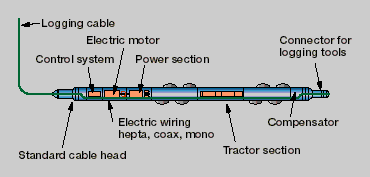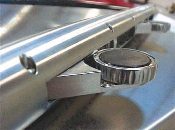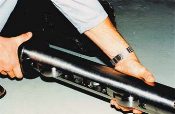Oryx runs "horizontal" production log with downhole tractor
DRILLING / COMPLETION TECHNOLOGYOryx runs "horizontal" production log with downhole tractorOperator cut cost / time by using new downhole tool to pull logging string into a long, highly-deviated North Sea wellboreJorgen Hallundbaek, Welltec Well Technologies
Oryx’s Well 38Z/26 required a production logging operation to optimize injection rates in offset wells, while monitoring any possible influx of water production. But, previous attempts to run production logs in the well had failed because the tools would not fall with gravity alone into the 63° deviated section. The tractor technology succeeded in logging the well by pulling logging tools to bottom on the end of electric wireline. Application Overview Deploying the MPL string downhole using the tractor facilitated economical access to the deviated section of the well by eliminating need for drill pipe conveyance, coiled tubing or snubbing unit pipe. Based on the profile of the well, Fig. 1, it was required to energize the tractor at a depth of 4,800 ft. The tool pulled the MPL string to a total measured depth of 19,170 ft. This run, alone, conveyed the logging string 14,370 ft out into the deviated section. After positioning the tools at the toe of the well, logging runs were made while winching the electric cable out of the well. Each time a logging pass was completed, the tractor was reactivated to deploy the string back downhole. A total of 10 logging passes were made, cumulatively covering 7,000 ft throughout the total length of the well. Within the 5-1/2-in. liner, the tractor covered a total distance of 21,370 ft, setting a new standard in deviated-well downhole tractor interventions. The tool has been extensively field proven and has demonstrated significant cost savings for operating companies when compared to previous methods of performing well intervention operations in "horizontal" wells. Oryx’s UK Superintendent of Well Services & Completions, Malcolm McCallum, says "Use of the tractor allows us to re-enter wells which previously could only be accessed by rig-based methods. This technology is now part of our standard portfolio of tools and it permits us to pursue extended-reach drilling opportunities while retaining the flexibility of sequential zonal management." The tool brings down costs, speeds up operations and reduces rig time considerably, the developer says. Jobs already run with the system have shown a reduction in cost of about 45% compared to coiled tubing / pipe-conveyed operations. Average estimated savings on a North Sea platform are in the range of $10 million per year. Today, it's possible to drill and complete highly deviated wells with nearly as much ease as conventional wells. However, intervention in such wells and in particular wells under pressure, presents far more of a challenge — until recently coiled tubing or snubbing have been the only options. Coiled tubing / snubbing interventions are logistically complex and require a longer operational time window than this new technology. The logistical problems, especially for CT work, are often enough to discourage the operation. For example on extended-reach development wells, required CT reel weight often exceeds the platform’s crane capacity. Alternatively, CT has to be spooled from the boat onto the platform and in situ field welding has to be carried out, joining the two or more sections together. If the CT is to be used for logging purposes, then a cable has to be installed inside the coil. This procedure must also be reversed before demobilizing CT equipment from the rig. In addition, it is expected that the market for production logging in extended-reach development and horizontal wells will increase due to the reduced intervention cost and simplified logistics of using the tractor as the method of conveyance. The idea of using a downhole tractor for pulling wireline into highly deviated or horizontal wells is not new. However, most other concepts have not left the drawing board or reached the prototype stage. Tractor Configuration, Operation The Welltec system has been designed to be run with standard wireline equipment and tools available in the field. The tool is the size, shape (3-1/8-in. OD, 21 ft long, or 2-1/8-in. OD, 20 ft) and weight of an average-sized logging tool and can be transported in the same manner as normal logging tools. The standard configuration of the 3-1/8-in. OD tool has been constructed to be able to drive along in a casing inside diameter (ID) range from 3.54 in. to a maximum 8.8 in. The 2-1/8-in. OD tool now has the ability to pass through a 2.30-in. ID and expand out to drive in all 7 in., 23 lb/ft casing. This automatically covers the standard 29 lb/ft range. The system comprises five main sections: surface communications and motor control panels, downhole electronics, hydraulic section, drive section and hydraulic compensator,. Fig. 2 illustrates the principal downhole-tool components. The surface communications and motor control panels are used to communicate with the tool to change from logging mode to tractor mode and to power the system in tractor mode. Displays show electrical current consumption and surface voltage. Depth and progress is monitored via the logging unit’s standard instrumentation.
The downhole electronics section can be switched between either tractor mode or logging mode. The signal which controls this is transmitted from the control panel on the surface. In tractor mode, the logging tools connected beneath the tractor are disconnected and the logging cable is connected directly to the AC motor. Tractor AC power is sent from surface and the electrical AC motor integrated in the tool drives a hydraulic pump.
The pump and the sequential control system are located in the hydraulic section. The hydraulic pump drives hydraulic fluid in a closed loop system through the drive sections. The four wheels in each drive section are in line and are pumped out with 180° phasing, two wheels in each direction, Fig. 3. Each drive section is rotated by 90°. The hydraulic compensator section equalizes the internal pressure with the downhole well pressure and temperature. After initial power-up, the wheels in each drive section are first pumped hydraulically out to a pre-set force. Then wheel rotation starts automatically and the tractor is driven forward. Once the system is powered down, the hydraulic oil is dumped to the internal reservoir and the wheels retract into the tractor body, Fig. 4. The retracted wheels protrude from the body slightly to assist running / pulling the toolstring in low-angle intervals. When the wheels are activated, they are pushed against the casing wall with a high normal force (adjustable from 200 to 1,500 lb per wheel) which provides necessary friction for the tractor to drive forward. In logging mode, the tools connected beneath the tractor can communicate as normal via the logging cable to surface. Power is not sent to drive wheels in logging mode, allowing logging to be conducted either with the tool stationary, or while pulling up out of the wellbore. The next-generation tractor will allow simultaneous tractoring and logging, in the same operation. The technology currently maintains applications for deploying most cased hole logging
tools along with openhole logging tools, while running on mono-conductor, coax or hepta /
multi-conductor type cable. The author
Copyright © 1999 World
Oil |
- Applying ultra-deep LWD resistivity technology successfully in a SAGD operation (May 2019)
- Adoption of wireless intelligent completions advances (May 2019)
- Majors double down as takeaway crunch eases (April 2019)
- What’s new in well logging and formation evaluation (April 2019)
- Qualification of a 20,000-psi subsea BOP: A collaborative approach (February 2019)
- ConocoPhillips’ Greg Leveille sees rapid trajectory of technical advancement continuing (February 2019)




 Jorgen
Hallundbaek, owner and founder of Welltec, earned
an MS from the Technical University of Denmark in 1988. Before starting on Well Tractor
developments, he, among other things, worked on 3-D wave simulations for platform
constructions, slimhole drilling and geotechnical surveys.
Jorgen
Hallundbaek, owner and founder of Welltec, earned
an MS from the Technical University of Denmark in 1988. Before starting on Well Tractor
developments, he, among other things, worked on 3-D wave simulations for platform
constructions, slimhole drilling and geotechnical surveys.
